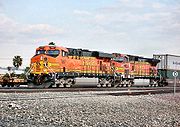
Canadian comfort cab
Encyclopedia



Cab (locomotive)
The cab, crew compartment or driver's compartment of a locomotive is the part of the locomotive housing the train driver or engineer, the fireman or driver's assistant , and the controls necessary for the locomotive's operation....
design found on modern diesel locomotives. It occupies the entire width of the locomotive, and typically has an access door on the front of the nose. The term wide cab is somewhat of a misnomer because it is the nose, not the cab, that is widened.
Development
The basic shape of the Canadian comfort cab first appeared on a hood unitHood unit
A hood unit, in railroad terminology, is a body style for diesel and electric locomotives. On a hood unit, the body of the locomotive is less than full-width for most of the locomotive's length, with walkways on the outside of the locomotive. In contrast, a cab unit has a full-width carbody for...
, the EMD DDA40X
EMD DDA40X
The EMD DDA40X was a D-D diesel-electric locomotive built by the General Motors EMD division of La Grange, Illinois for the Union Pacific Railroad...
, in 1969. It was the same design as the F45
EMD F45
An EMD F45 is a C-C cowled diesel-electric locomotive built by General Motors Electro-Motive Division between 1968 and 1971. Power was provided by an EMD 645E3 20-cylinder engine which generated .-Design:...
and FP45
EMD FP45
The EMD FP45 is a cowl unit type of C-C diesel locomotive produced in the United States by General Motors Electro-Motive Division. It was produced beginning in 1967 at the request of the Atchison, Topeka and Santa Fe Railway, which did not want its prestigious Super Chief and other passenger...
cowl unit
Cowl unit
A cowl unit is a body style of diesel locomotive. The terminology is a North American one, though similar locomotives exist elsewhere. A cowl unit is one with full-width enclosing bodywork, similar to the cab unit style of earlier locomotives, but unlike the cab unit style, the bodywork is merely...
s being built by EMD at the time. The cab used on the F45, FP45 and DDA40X was not a true Canadian comfort (or "Safety") cab because it consisted mainly of restyled sheet metal and lacked the structural reinforcements of the Canadian design.
EMD Design
The first true Canadian cabs were designed and built for the Canadian National RailwayCanadian National Railway
The Canadian National Railway Company is a Canadian Class I railway headquartered in Montreal, Quebec. CN's slogan is "North America's Railroad"....
by input from railway employees. The locomotives were GP38-2s
EMD GP38-2
An EMD GP38-2 is a four-axle diesel-electric locomotive of the road switcher type built by General Motors Electro-Motive Division. Part of the EMD Dash 2 line, the GP38-2 was an upgraded version of the earlier GP38...
, GP40-2s and GP40-2Ls
EMD GP40-2
An EMD GP40-2 is a 4-axle diesel road switcher locomotive built by General Motors Electro-Motive Division as part of its Dash 2 line between April 1972 and December 1986. Power was provided by an EMD 645E3 16-cylinder engine which generated 3000 horsepower .- Production :Standard GP40-2 production...
, and SD40-2s
EMD SD40-2
The EMD SD40-2 is a C-C locomotive produced by EMD from 1972 to 1989.The SD40-2 was first introduced in January 1972 as the mid-range offering in EMD's six-axle "Dash-2" series, competing against the GE U30C and the MLW M630...
. To denote the presence of the wide-nosed cab, a "W" was often applied at the end of the model name (i.e. GP38-2W, GP40-2W, SD40-2W), although this was not an official designation. The Montreal Locomotive Works also offered a competitive cab design on their M-420 and M-630(W) models. GE and EMD began offering the wide cab as a standard option instead of a custom build option in 1988.
The first Canadian comfort cab appeared in 1973 on CN #5560, the last unit in an order of standard cab-equipped GP38-2s. The first series of comfort cabs were on an order of MLW (Montreal Locomotive Works) M-420s, also built for CN in 1973.
Cab design
The wide cab design has a number of safety features as well as a number of crew comfort features.Safety
The wide cab is built with a specially reinforced nose. Instead of sheet metal, 3/8-inch-thick steel is employed with additional reinforcement behind the armor. As a moving locomotive cannot maneuver to avoid collisions and frequently cannot stop in time to prevent them, these enhancements serve to protect the crew in the event of a collision with objects smaller than the train itself such as downed trees or stopped automobiles. In addition, the windows of the cab meet Federal Railroad AdministrationFederal Railroad Administration
The Federal Railroad Administration is an agency in the United States Department of Transportation. The agency was created by the Department of Transportation Act of 1966...
Regulations Part 223,
which states that windows must withstand the impact of a .22 caliber bullet or a cinder block
Cinder block
In the United States, a concrete masonry unit – also called concrete block, cement block, and foundation block – is a large rectangular brick used in construction. Concrete blocks are made from cast concrete, i.e. Portland cement and aggregate, usually sand and fine gravel for high-density blocks...
.

